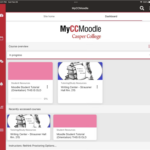Casper College’s mobile app is a win, win, win, win, win, etc., etc., situation for the campus. Students can attend a class from anywhere, they can take quizzes, connect with instructors, and download assignments for offline work—and it’s fully branded by the Wyoming community college.
 “It looks and feels like Casper College,” says David Siemens, the school’s director of digital learning. “It brings our campus and our LMS and the way we do things to students’ homes.”
“It looks and feels like Casper College,” says David Siemens, the school’s director of digital learning. “It brings our campus and our LMS and the way we do things to students’ homes.”
The college worked with Open LMS to create a mobile app that gives students and instructors direct access to the campus’ Moodle learning management system. Because internet connectivity can be a barrier for some students in the vast rural areas of Wyoming, designers added a key feature, says Phil Miller, managing director of Open LMS.
“It allows offline access,” Miller says. “Students can download coursework into the mobile app and do the work when they don’t have connectivity, and sync back up when they’re reconnected.”
A mobile app also appeals to the rapidly growing number of students who prefer doing their work on a mobile device. One reason for this movement is convenience—students want to consume content on their phones.
More from UB: Is your college following the 10 best practices for financial aid transparency?
Mobile LMS apps also provide flexibility for students who have jobs, families and other responsibilities beyond higher ed. The typical student at Casper College is not the typical 18- or 19-year-old right out of high school. The institution’s adult learners want options to complete their coursework at night and on weekends.
“The ability to complete your education while still living your whole life is something that really matters to the average student at Casper College now,” Miller adds.
Providing convenience and meeting needs are both ways to increase student engagement and create the conditions for self-directed learning. Since the app launched earlier this year, about 50% of Casper’s students have downloaded it and each user is accessing it about 11 times a week.
The high adoption rate can be attributed to its extensive Casper College branding, which allows students to easily locate it in app stores, Miller explains. And for those who want to get technical, Open LMS’ source code is—just like it sounds—open, which lets institutions modify and tailor an app for their own purposes.








